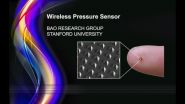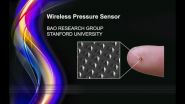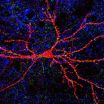(Press-News.org) Stanford engineers have invented a wireless pressure sensor that has already been used to measure brain pressure in lab mice with brain injuries.
The underlying technology has such broad potential that it could one day be used to create skin-like materials that can sense pressure, leading to prosthetic devices with the electronic equivalent of a sense of touch.
A nine-member research team led by Chemical Engineering Professor Zhenan Bao detailed two medical applications of this technology in Nature Communications.
In one simple demonstration they used this wireless pressure sensor to read a team member's pulse without touching him.
In a more complex application, they used this wireless device to monitor the pressure inside the skull of a lab mouse, an achievement that could one day lead to better ways to treat human brain injuries.
Bao's wireless sensor is made by placing a thin layer of specially designed rubber between two strips of copper. The copper strips act like radio antennas. The rubber serves as an insulator.
The technology involves beaming radio waves through this simple antenna-and-rubber sandwich. When the device comes under pressure, the copper antennas squeeze the rubber insulator and move infinitesimally closer together.
That tiny change in proximity alters the electrical characteristics of the device. Radio waves passing through the two antennas slow down in terms of frequency. When pressure is relaxed, the copper antennas move apart and the radio waves accelerate in frequency.
The engineers proved that this effect was measurable, giving them a way to gauge the pressure exerted on the device by tracking the frequency of radio waves passing through the device.
Former Stanford graduate students Lisa Chen and Benjamin C-K Tee designed and modeled the physics behind the device, and calibrated the pressure sensor in simple laboratory tests. Alex Chortos, graduate student in the department of materials science and engineering, made the wireless device more robust and re-usable.
When the engineers sought collaborators to test the device in potentially useful applications, H.–S. Philip Wong, a professor of electrical engineering, connected them with Victor Tse, a neurosurgeon and consulting associate professor at Stanford School of Medicine.
Tse tested the wireless pressure sensor as a tool for managing patients with severe brain trauma. The most devastating problem in such cases is brain swelling. Currently, physicians diagnose brain swelling with imaging techniques such as CT scans or by monitoring intracranial pressure (ICP) directly.
ICP monitoring is traditionally done using probes that penetrate the skull and are linked to an external monitor via a cable. In addition to the possibility of the cable being pulled out or dislodged, this cumbersome solution carries the risk of infection. Measuring ICP using cables become particularly challenging when patients are moved within the hospital or transported to other facilities.
In experiments on laboratory mice, Tse used radio waves to probe Bao's wireless sensor, allowing him to monitor changes in intracranial pressure continuously.
"Our team is now considering how to incorporate this device into a catheter that could siphon out cerebral spinal fluid whenever there is an increase in ICP," Tse said. On a slightly different tack, his team is thinking about how to retool the wireless sensor so that it could be placed in the eye socket. There it could be used to measure pressure in the eye socket, a relatively easy-to-obtain surrogate for tracking intracranial pressure on the brain.
In a separate effort, Dr. Michael McConnell, a professor of cardiovascular medicine, used the device to take a wireless pulse reading as a proof of principle that the technology could be applied to pressures having to do with blood circulation.
For Bao, this is the latest in a series of experiments that capitalize on a simple but far-reaching advance that her lab made several years ago. That advance has to do with the design of the rubber layer used in this device.
As Bao explained, rubber is special because its basic molecular structure can compress and spring back into shape. Other materials simply don't have this spring-like feature. Simple as it may seem, her lab discovered that creating a pyramid-shaped layer of rubber instead of a flat mat gave the individual rubber molecules more freedom to flatten out and then spring back into shape.
By putting this pyramid-shaped rubber layer between the copper antennas, this team of engineers was able to exploit the subtle interactions of radio waves and electron clouds to create a pressure gauge.
VIDEO:
See and hear how the wireless sensor uses frequency changes in radio waves to gauge pressure.
Click here for more information.
Bao foresees many potential applications for this pressure-sensing technology.
"The device we invented here is extremely easy to manufacture and consumes no energy until readings are being made," she said. "In the short term we hope to use devices like this to track packages and monitor health conditions. In the longer run we dream of using this technology to create touch-sensitive lining for prosthetic devices."
INFORMATION:
Media contact:
Tom Abate, Associate Director of Communications, Stanford Engineering, 650-736-2245, tabate@stanford.edu
Researchers from the University of Melbourne have established how two diseases that present in similar ways are in fact quite different.
Progressive Supranuclear palsy and Parkinson's Disease have overlapping symptoms but remain difficult to distinguish.
However, a first ever paper on the topic published in the Journal of Neuropsychology (British Psychological Society publication) now suggests that people with PSP experience more severe and extensive cognitive impairments than those with PD early on.
The study indicates that patients with PSP experience more severe ...
The initial benefits of an outpatient antimicrobial stewardship intervention designed to reduce the rate of inappropriate antibiotic prescriptions were lost after discontinuation of audit and feedback to clinicians, according to a study published in JAMA. The study is being released early online to coincide with the IDWeek 2014 meeting.
Antibiotics are the most frequently prescribed medications for children; most are prescribed for outpatient acute respiratory tract infections. Because antibiotic prescribing is often inappropriate, Jeffrey S. Gerber, M.D., Ph.D., of ...
The so-called Signal Transducers and Activators of Transcription, or STATs, are key components of many different signalling pathways. Not surprisingly, then, when something goes wrong with their regulation the consequences can be severe and many types of cancer are known to be associated with increased activities of one or more STAT protein. STAT3 is a frequent culprit and is often found to be activated in tumour cells.
Considerable efforts are going into developing inhibitors of STAT3 for use in cancer therapy but it is unclear whether these will turn out to be suitable ...
New research out of Queen's University could give insight into what terrorists are thinking. Professor David Skillicorn (School of Computing) analyzed language used in two jihadist magazines to gain intelligence about terrorist strategy.
He examined the language used in Inspire, an online magazine reportedly published by al-Qaida in the Arabian Peninsula, which aims to increase the availability of their message, and the Islamic State News published by ISIS. Inspire has attracted attention because of its goal of attracting lone-wolf attacks in Western countries.
"The payoff ...
The immunosuppressive drug fingolimod (trade name: Gilenya) was approved for an expanded therapeutic indication in May 2014: It is now also available for adults with highly active relapsing remitting multiple sclerosis (RRMS) who had received other pretreatment than interferon beta (IFN-β). In an early benefit assessment pursuant to the Act on the Reform of the Market for Medicinal Products (AMNOG), the German Institute for Quality and Efficiency in Health Care (IQWiG) examined whether the drug offers an added benefit over the appropriate comparator therapy in this ...
A previously unknown mechanism through which the brain produces new nerve cells after a stroke has been discovered at Lund University and Karolinska Institute in Sweden. The findings have been published in the journal SCIENCE.
A stroke is caused by a blood clot blocking a blood vessel in the brain, which leads to an interruption of blood flow and therefore a shortage of oxygen. Many nerve cells die, resulting in motor, sensory and cognitive problems.
The researchers have shown that following an induced stroke in mice, support cells, so-called astrocytes, start to form ...
A novel technique which reduces image degradation caused by respiratory motion during a PET scan was developed in a recent study at the University of Eastern Finland. PET scanning is routinely used to detect cancer and heart conditions. The new technique presented in the PhD thesis of Tuomas Koivumäki, MSc (Tech.), is based on bioimpedance measurement and it allows for image reconstruction at a specific phase of the patient's breathing pattern. This, in turn, makes it possible to reduce image degradation caused by motion.
In the future, the newly developed technique ...
New Orleans, LA – A special study using data from LSU Health New Orleans School of Public Health's Louisiana Tumor Registry has found that colorectal cancer incidence rates in the Louisiana Acadian parishes are among the highest in the United States. This study appears to be the first to identify a high rate of cancer in a large, regional, US founder population, raising the possibility of a genetic predisposition. Alternatively, an unidentified, robust environmental risk factor may be present. The paper is published online in Clinical and Translational Gastroenterology, ...
A small, "empty" space teeming with activity: a synapse is a complex structure where the neural (electrical) signal from the presynaptic neuron, as it travels towards its target –a muscle, a gland or another neuron – turns into a chemical signal capable of crossing the synaptic space before becoming electrical again once on the other side. A synapse is a "dynamic" space not only because of the endless work that goes on there, but also for its ability to change its action over time (synaptic plasticity) as a result of either normal physiological processes (e.g., ...
The sanitation intervention delivered under the terms of the Government of India's Total Sanitation Campaign—the world's largest sanitation initiative—provided almost 25 000 individuals in rural India with access to a latrine. However, it did not reduce exposure to faecal pathogens or decrease the occurrence of diarrhoea, parasitic worm infections, or child malnutrition.
"The programme is effective in building latrines, but not all households participate"*, explains lead author Professor Thomas Clasen from Emory University, Atlanta, USA and the London School ...




